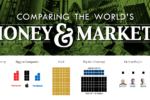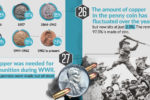
Infographic: The Properties of Money
While a deeper look at money did raise many questions, there are at least some foundational truths that can be discerned about money.
For example, many economists and experts in the field agree that money must be a medium of exchange, a unit of account, and a store of value:
Medium of Exchange
- Definition: Can be used to intermediate the exchange of goods and services.
- Use: A common ground for determining value.
- Example: A community uses beaver pelts as a medium to trade for other goods.
Unit of Account
- Definition: A standard numerical unit of measurement of market value for goods, services, and other transactions.
- Use: Can be used to compare goods using a common system.
- Example: Housing prices in Japan can be compared using the yen as a unit of account.
Store of Value
- Definition: Maintains its value over time.
- Use: Can be spent or exchanged at a later date without penalty.
- Example: An ounce of gold could buy a toga in Roman times, yet it can still buy a nice suit today.
In other words, money must meet be:
- Divisible: Can be divided into smaller units of value.
- Fungible: One unit is viewed as interchangeable with another.
- Portable: Individuals can carry money with them and transfer it to others.
- Durable: An item must be able to withstand being used repeatedly.
- Acceptable: Everyone must be able to use the money for transactions.
- Uniform: All versions of the same denomination must have the same purchasing power.
- Limited in Supply: The supply of money in circulation ensures values remain relatively constant.
The above properties of money will certainly help us uncover more truths, but there are still problems:
What happens if money no longer holds its value?
What happens if money supply is no longer limited?
Where does money’s value come from?
What is difference between money and debt, and how much is there?
The Money Project acknowledges that the very concept of money itself is in flux – and it seeks to answer these questions.
About the Money Project
The Money Project aims to use intuitive visualizations to explore ideas around the very concept of money itself. Founded in 2015 by Visual Capitalist and Texas Precious Metals, the Money Project will look at the evolving nature of money, and will try to answer the difficult questions that prevent us from truly understanding the role that money plays in finance, investments, and accumulating wealth.
Embed This Image On Your Site (copy code below):






